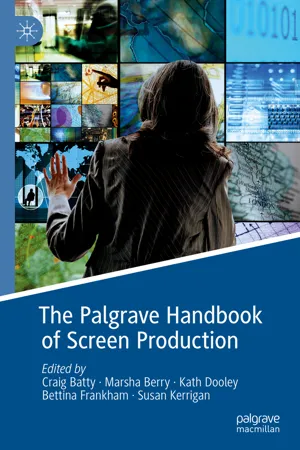
The Palgrave Handbook of Screen Production
- English
- ePUB (mobile friendly)
- Available on iOS & Android
The Palgrave Handbook of Screen Production
About this book
This handbook is an essential creative, critical and practical guide for students and educators of screen production internationally. It covers all aspects of screen production—from conceptualizing ideas and developing them, to realizing and then distributing them—across all forms and formats, including fiction and non-fiction for cinema, television, gallery spaces and the web. With chapters by practitioners, scholars and educators from around the world, the book provides a comprehensive collection of approaches for those studying and teaching the development and production of screen content. With college and university students in mind, the volume purposely combines theory and practice to offer a critically informed and intellectually rich guide to screen production, shaped by the needs of those working in education environments where 'doing' and 'thinking' must co-exist. The Palgrave Handbook of Screen Production fills an important gap in creative-critical knowledge of screen production, while also providing practical tools and approaches for future practitioners.
Frequently asked questions
- Essential is ideal for learners and professionals who enjoy exploring a wide range of subjects. Access the Essential Library with 800,000+ trusted titles and best-sellers across business, personal growth, and the humanities. Includes unlimited reading time and Standard Read Aloud voice.
- Complete: Perfect for advanced learners and researchers needing full, unrestricted access. Unlock 1.4M+ books across hundreds of subjects, including academic and specialized titles. The Complete Plan also includes advanced features like Premium Read Aloud and Research Assistant.
Please note we cannot support devices running on iOS 13 and Android 7 or earlier. Learn more about using the app.
Information
Part I
Creative Filmmaking Processes, Procedures and Practices: Embodied and Internalized Filmmaking Agency
Table of contents
- Cover
- Front Matter
- Part I
- Part II
- Part III
- Part IV
- Part V
- Back Matter